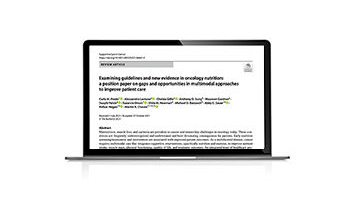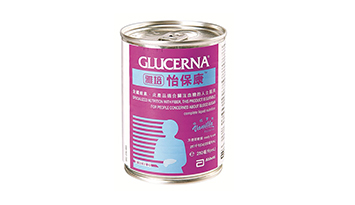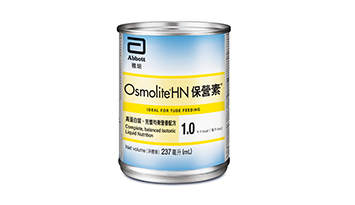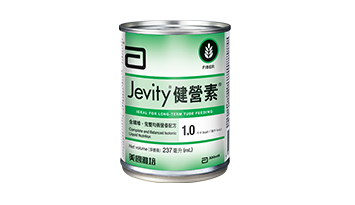Glucerna® Powder vanilla flavor 850g▲
GLUCERNA POWDER
Glucerna® Powder vanilla flavor 400g▲
MOST CLINICALLY PROVEN DIABETES NUTRITION BRAND IN THE WORLD△
- Advanced, complex, slowly digested, carbohydrate blend with low GI ingredients^ (including dual fiber blend) to help manage blood sugar
- Helps promote the secretion of GLP-1 to improve insulin secretion1, helps lower postprandial glucose response2,3 and HbA1c4
- Contains 4x myo-inositol† to help improve insulin sensitivity#,5-7
- Complete, balanced nutrition with 18 vitamins & minerals and low sugar, low-GI* formulation
- Nutrition profile meets recommendations of ADA***
IMPORTED FROM SINGAPORE
Ingredients
Maltodextrin, VEGETABLE OILS (high oleic sunflower oil, soy oil), calcium caseinate, sucromalt, isolated soy protein, maltitol, milk protein concentrate, fructose, MINERALS (potassium chloride, magnesium phosphate dibasic, potassium phosphate dibasic, calcium carbonate, sodium chloride, sodium sulfate, magnesium sulfate, potassium citrate, sodium citrate, zinc sulfate, ferrous sulfate, manganese sulfate, copper sulfate, chromium picolinate, chromium chloride, potassium iodide, sodium molybdate, sodium selenate), oligofructose, isomaltulose, myo-inositol, oat fiber, flavoring, stabilizer (carboxymethyl cellulose), choline chloride, emulsifier (lecithin), VITAMINS (ascorbic acid, antioxidant (ascorbyl palmitate), antioxidant (mixed tocopherols), Vitamin E, niacinamide, calcium pantothenate, thiamin hydrochloride, pyridoxine hydrochloride, riboflavin, Vitamin A palmitate, folic acid, phylloquinone, biotin, Vitamin D3, cyanocobalamin), stabilizer (xanthan gum), taurine, L-carnitine. Fibersol-2 is used as part of maltodextrin.
Contains milk and soy ingredients.
Nutrition Information
RELATED PRODUCTS
RELATED CONTENT
Examining guidelines and new evidence in oncology nutrition
Examining guidelines and new evidence in oncology nutrition
- Logo
-

- Main Image
-

- Tagname
- Article
- Logo link
- title
- Examining guidelines and new evidence in oncology nutrition: a position paper on gaps and opportunities in multimodal approaches to improve patient care
- Content Reference
- /content/an/hcpproconnect/hk/en/home/adult/resources/public/Examining-guidelines-and-new-evidence-in-oncology-nutrition-a-position-paper-on-gaps-and-opportunities-in-multimodal-approaches-to-improve-pati
- Abstract
-
Malnutrition, muscle loss, and cachexia are prevalent in cancer and remain key challenges in oncology today. These conditions are frequently underrecognised and undertreated and have devastating consequences for patients. Early nutrition screening/assessment and intervention are associated with improved patient outcomes.
- Publish Date:
- Oct 2021
The Benefits of Beta-Hydroxy-Beta-Methylbutyrate (or HMB)
- Logo
-

- Main Image
-

- Tagname
- ARTICLE
- Logo link
- title
- The Benefits of Beta-Hydroxy-Beta-Methylbutyrate (or HMB)
- Content Reference
- /content/an/hcpproconnect/hk/en/home/adult/resources/public/hmb-article
- Abstract
-
The benefits of oral nutritional supplements containing HMB are supported by evidence from over 18 clinical studies,9-27 read this short article to learn more about the benefits of HMB.
- Publish Date:
The Underappreciated Role of Low Muscle Mass in the Management of Malnutrition
The Underappreciated Role of Low Muscle Mass in the Management of Malnutrition
- Logo
-

- Main Image
-

- Tagname
- Article
- Logo link
- title
- The Underappreciated Role of Low Muscle Mass in the Management of Malnutrition
- Content Reference
- /content/an/hcpproconnect/hk/en/home/adult/resources/public/The-Underappreciated-Role-of-Low-Muscle-Mass-in-the-Management-of-Malnutrition
- Abstract
-
This opinion article, published in Journal of American Medical Directors Association (JAMDA), addresses the role of muscle mass in improving health outcomes in a variety of disease states. It also offers strategies you can use to help patients manage low muscle mass and prevent muscle loss.
- Publish Date:
- Jan 2019

The Importance of Muscle Strength for Patient Outcomes
Muscle strength is important for patients' quality of life. Muscle loss naturally decreases with age and can have devasating consequences. However, muscle loss can be reversed with early nutritional intervention.

strength for life - copd
COPD patients often experience reduced respiratory muscle endurance, which can impact disease trajectory. Early assessment and intervention is critical to improve patient outcomes

Gain to Lose! Can increased Muscle Mass decrease the fat in the body?
Traditional weight loss programs often focus on cutting body fat and hitting lower numbers on the scale but do not focus on gaining muscles.
Footnotes:
△ Based on published clinical studies only. Literature search was conducted in Dialog databases and Dimensions full-text searching database in August 2022.
*** American Diabetes Association. Diabetes Care 2023;46(Suppl 1):S68-S96. Meets American Diabetes Association's recommendations for dietary fiber, sodium, monounsaturated fatty acids, polyunsaturated fatty acids, trans fatty acids and saturated fatty acids.
▲ This product is not registered under the Pharmacy and Poisons Ordinance or the Chinese Medicine Ordinance. Any claim made for it has not been subject to evaluation for such registration. This product is not intended to diagnose, treat or prevent any disease. 此產品沒有根據<藥劑業及毒藥條例>或<中醫藥條例>註冊。為此產品作出的任何聲稱亦沒有為進行該等註冊而接受評核。此產品並不供作診斷、治療或預防任何疾病之用。
^ Low glycemic index ingredients include: (for Powder) fibersol-2, sucromalt, maltitol, fructose, isomaltulose, FOS and oat fiber.
† New Glucerna contains 337.9mg/100ml (Powder), 292mg/100ml (Bottle); Previous Glucerna contained 84mg/100ml (Powder), 0mg/100ml (Bottle); Compared with previous Glucerna triple care formulation.
#Inositol helps supports insulin sensitivity by promoting GLUT4 translocation thus increasing glucose entry into the cell.
*Sugar 2.4g/100ml, GI=31 (for Powder)
References:
- Devitt AA et al., J Diabetes Res Clin Mtab. 2012;1:20
- Mottalib et al., Nutrients. 2016 Jul 11;8(7):443
- Devitt AA et al., Advances in Bioscience and Biotechnology, 2013, 4, 1-10
- Chee SS et al., BMJ Open Diabetes Res Care. 2017;5(1):e000384.
- Bevilacqua A, et al. Int J Endocrinol. 2018:1968450
- Dang NT, et al. Biosci Biotechnol Biochem. 2010;74(5):1062-1067
- Yamashita Y, et al. J agric Food Chem. 2013;61(20):4850-4854
HKG.2025.58198.AND.1








